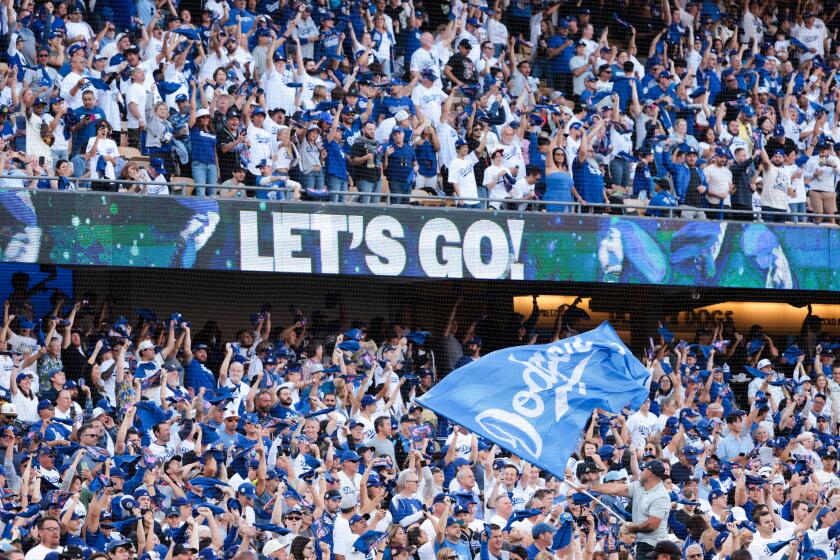Spring is still in his step
It is another spring of our lives, signaled by the sound of bat against ball. No need for Groundhog Day. We see scuffed spikes and chalked lines in Florida and Arizona.
The man across the table is a perfect lunch companion for the giddiness of spring, when everybody is in first place and pennant talk is equally acceptable in the New York Yankees’ and Pittsburgh Pirates’ camps. That first week of April, the return to reality, is indistinguishably distant.
At 71, Peter O’Malley is only 11 years removed from when he sold the Dodgers to Fox. Family became corporate. Doing it right became doing it for dollars. Now, that ownership is back to family, the McCourts. But the jury remains out on whether competitiveness or cash is the driving force.
O’Malley says he has no regrets, that he misses it, but is comfortable with the decision to sell and take care of his family’s future. He knows the days of serving ice cream to an office staff at 2 p.m. every day that the Dodgers were in first place probably is more quaint than realistic now.
He watches closely and clings a bit to the past, befitting a person his age.
“I have gone on the record as saying I wouldn’t have moved the Dodgers out of Vero Beach,” he says. “I would have found new revenue streams.”
There is a new book out about his late father and predecessor as Dodgers owner, Hall of Famer Walter O’Malley. It is called “Forever Blue,” and Peter O’Malley is going to Vero Beach for a book party on St. Patrick’s Day.
Will he visit Dodgertown?
“I’m not sure,” he says.
He understands the tension and trauma of a free-agent chase, and follows the quest for Manny Ramirez with interest and understanding.
“I remember when we had to sign Fernando [Valenzuela],” O’Malley says. “You think Scott Boras is tough. You should have dealt with Dick Moss. I remember our approach: firm, but fair. And it worked.”
He also remembers the day, probably sometime in the early 1990s, watching from his owner’s box, as a home run flew out of the park.
“It was a pinch-hitter. No wind. He took a check swing, and out it went,” he says. “I turned to somebody in my box and said I had never seen anything like that before. I said that the ball must be juiced.”
Now, of course, we know that the player was probably juiced.
It is a subject, steroids in baseball, that O’Malley addresses passionately. In the sun and warmth of spring training, he sees clouds.
“Not just storm clouds, a storm,” he says.
“They called it the Black Sox Scandal. From what I know, this is comparable, maybe more severe.
“What is happening today is tragic. Does it make me angry? Not as much as it disappoints me.”
O’Malley says that, in the wake of Alex Rodriguez’s recent admission of steroid use, baseball fans are waiting for “the other shoe to drop.” He defines that as any new evidence, new names, new revelations that will push fans further from the sport.
“I fear there is a closet full of shoes,” he says.
“Fans are waiting to see if their favorite player used the stuff. Or if the pitcher who struck out their favorite player did.”
He says baseball can’t take many more revelations.
“There are four constituents in the game: players, owners, agents and the union,” O’Malley says. “They need to get together now, and act quickly, decisively and intelligently. Not separately. Together.
“This is not going to go away, not going to disappear. If they don’t deal with it now, an outside party -- Congress maybe -- will step in and do it for them.”
On the luncheon table rested two stories from Friday’s New York Times about many baseball players reporting to spring training this year 20 to 30 pounds below their past playing weight. The writers adeptly allowed the players to explain. One said he lost weight by playing video games with his children. Another said he did yoga, while a third said he did it by going to bed every night at 9:30.
Maybe. Or maybe baseball’s steroid era has become such a joke that the last laugh will be represented by empty seats and dwindling TV ratings.
The romance of baseball has always begun with the spring. In places such as Milwaukee and Minneapolis, when pitchers and catchers report for spring training, it means the buds on trees buried in snowbanks cannot be far behind. With summer comes more sunshine, the real games, and more romance.
The early 1950s Dodgers of the O’Malleys remain the symbol of all this, as painted in the baseball’s best book, Roger Kahn’s “The Boys of Summer.”
Now, the romance stalls, with action to return it nowhere on the horizon. Left to linger, somebody will write the sequel to Kahn’s work and call it “The Frauds of Summer.”
“This is not anywhere near behind us yet,” O’Malley says.
--
More to Read
Are you a true-blue fan?
Get our Dodgers Dugout newsletter for insights, news and much more.
You may occasionally receive promotional content from the Los Angeles Times.










